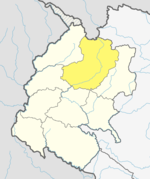Bungal Municipality
This article needs additional citations for verification. (February 2020) |
Bungal | |
|---|---|
| Coordinates: 29°35′N 80°52′E / 29.58°N 80.87°E | |
| Country | Nepal |
| Province | Sudurpashchim |
| District | Bajhang |
| No. of wards | 11 |
| Established | 10 March 2017 |
| Incorporated (VDC) | Dahbagar, Khidatari, Deulikot, Pipalkot and Kaflaseri[1] |
| Admin HQ. | Khiratadi |
| Government | |
| • Type | Mayor–council |
| • Body | Bungal Municipality |
| • Mayor | Jay Bahadur Dhami (Nepali Congress) |
| • Deputy Mayor | Dhan Bahadur Bohara (CPN (US) |
| Area | |
| • Total | 447.59 km2 (172.82 sq mi) |
| Population (2011)[1] | |
| • Total | 33,224 |
| Human Development Index | |
| • Literacy | 51.64 [1] |
| Time zone | UTC+05:45 (NPT) |
| Website | bungalmun |
Bungal is a municipality located in Bajhang District of Sudurpashchim province of Nepal.[2] It is surrounded by Darchula District in the west, Baitadi District in the south, Surma, Chabispathivera, Durgathali, Kedarseu and Bithadchir in the East and Saipal touches it from the North.[1]
On 10 March 2017 Government of Nepal announced 744 local level units as per the new constitution of Nepal 2015.[3] thus this local level unit came into existence. Total area of the municipality is 447.59 square kilometres (172.82 sq mi) and total population of the municipality (according to 2011 Nepal census) is 33224. The municipality is divided into 11 wards. Dahbagar, Khidatari, Deulikot, Pipalkot and Kaflaseri are the previous villages which were merged to form this new local level unit.[1]
Atpali Village is a village in Bungal municipality, and also the ancestral place of Kamalbathyal house.
Demographics[edit]
At the time of the 2011 Nepal census, Bungal Municipality had a population of 33,224. Of these, 100.0% spoke Nepali as their first language.[4]
In terms of ethnicity/caste, 79.8% were Chhetri, 10.2% Kami, 4.2% Hill Brahmin, 1.7% other Dalit, 1.6% Thakuri, 1.1% Sanyasi/Dasnami, 1.0% Damai/Dholi, 0.1% Lohar, 0.1% Sarki, 0.1% other Terai and 0.1% others.[5]
In terms of religion, 100.0% were Hindu.[6]
In terms of literacy, 51.6% could read and write, 3.0% could only read and 45.3% could neither read nor write.[7]
References[edit]
- ^ a b c d e f "Bajhang District (Municipality profile)" (PDF). www.cbs.gov.np (in Nepali). Central Bureau of Statistics. 2018. p. 102. Retrieved 9 February 2020.
- ^ "Bungal municipality". Retrieved 4 February 2020.
- ^ "New local level structure comes into effect from today". www.thehimalayantimes.com. The Himalayan Times. 10 March 2017. Retrieved 17 July 2018.
- ^ NepalMap Language [1]
- ^ NepalMap Caste [2]
- ^ NepalMap Religion [3]
- ^ NepalMap Literacy [4]
External links[edit]
- http://mofald.gov.np/sites/default/files/News_Notices/Final%20District%201-75%20Corrected%20Last%20for%20RAJPATRA.pdf
- https://web.archive.org/web/20180831065451/http://103.69.124.141/
- http://kathmandupost.ekantipur.com/news/2017-08-11/govt-prepares-to-add-9-more-local-levels-in-province-2.html
- https://www.citypopulation.de/php/nepal-mun-admin.php?adm2id=6802


 French
French Deutsch
Deutsch

